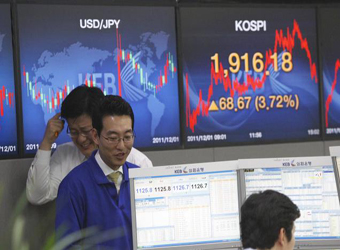Most Asian markets refused to budge on Wednesday in the face of uncertainty over monetary policy in the United States and Europe, though Japanese stocks managed to buck the trend thanks to gains in major car makers.
Tokyo shares stood out with a 0.9 percent rise .N225 led by a 1.3 percent jump in Toyota (7203.T) on reports it was about to raise its profit forecasts.
Excitement was sorely lacking otherwise, with MSCI’s index of Asia-Pacific shares outside Japan .MIAPJ0000PUS inching up 0.1 percent. Australia’s main index was all but flat .AXJO, as were shares in Shanghai .SSEC.
Investors mostly took their cue from Wall Street which had turned lower on Tuesday after the Institute for Supply Management’s October read on U.S. services came in at a surprisingly strong 55.4.
It also showed a notable jump in the employment outlook which could lessen the chance of a very weak payrolls number on Friday. <TOP/CEN>
While evidence of economic resilience was welcome, it also adds to the case for the Fed to wind back its bond buying program. Most analysts still favor March as the window for a move, but a shift in December is a growing risk.
That pressured Treasury prices and lifted yields on 10-year notes 5 basis points to 2.66 percent, while markedly widening the gap between long and short-term rates.
Equity investors reacted with caution, leaving the Dow Jones industrial average .DJI down 0.13 percent on Tuesday, while the S&P 500 Index .SPX eased 0.28 percent.
The contrast with the euro zone was stark as a string of disappointing economic numbers piled pressure on the European Central Bank (ECB) to take action, if not at its policy meeting on Thursday, then certainly by December.
“We expect the ECB to soon make clear its intentions regarding arresting deflation concerns,” analysts at Barclays Capital wrote in a note to clients.
“We anticipate a looser monetary stance to be adopted at the December meeting, but the ECB’s intentions to be aired ahead of it.”
FED RESEARCH DRAWS INTEREST
Expectations of a dovish turn by the ECB kept the euro on the defensive, though it did manage to bounce to $1.3508 in the Asian session from an early $1.3469. Dealers reported talk of buying by a Swiss bank, perhaps covering a short position ahead of the ECB meeting.
The dollar pared its recent gains against a basket of major currencies and dipped 0.2 percent .DXY, even while it edged up on the Japanese yen to 98.64.
Dealers also reported interest in a couple of research papers from top Fed officials that suggested there was scope for the central bank to provide even more stimulus to the economy.
The research tended to favor more relaxed thresholds for when the Fed might consider an increase in the funds rate, a form of forward guidance for markets.
Currently the Fed has said it would not consider a funds hike until unemployment had fallen to at least 6.5 percent.
Jan Hatzius, chief economist at Goldman Sachs, felt the papers were important enough to alter his outlook for policy.
“The studies suggest that some of the most senior Fed staffers see strong arguments for a significantly greater amount of monetary stimulus,” he wrote in a note to clients.
“Our central case is now that the FOMC will reduce the threshold from 6.5 percent to 6 percent at the March Open Market Committee meeting.”
New Zealand added to the run of better global economic news as employment jumped well past forecasts in the three months to September, while the jobless rate dropped to 6.2 percent.
The robust report prompted investors to bring forward expectations for when interest rates might rise in New Zealand to early next year. It is already likely to be the first of any developed nation to tighten policy this cycle.
The country’s dollar climbed a third of a U.S. cent on the news to $0.8386.
In commodity markets, gold was a few bucks firmer at $1,314.71 and trying to stabilize after seven straight sessions of losses. Copper rose 0.2 percent. <GOL/>
Oil prices recouped just a little of their recent losses, which had seen U.S. crude end at a five-month trough on Tuesday.
Growing U.S. supplies have continued to pressure oil prices, with U.S. crude ending on Tuesday at a five-month low <O/R>.
Brent crude regained 60 cents to $105.93 a barrel, while NYMEX crude futures bounced 52 cents to $93.89.
Source: Reuters
